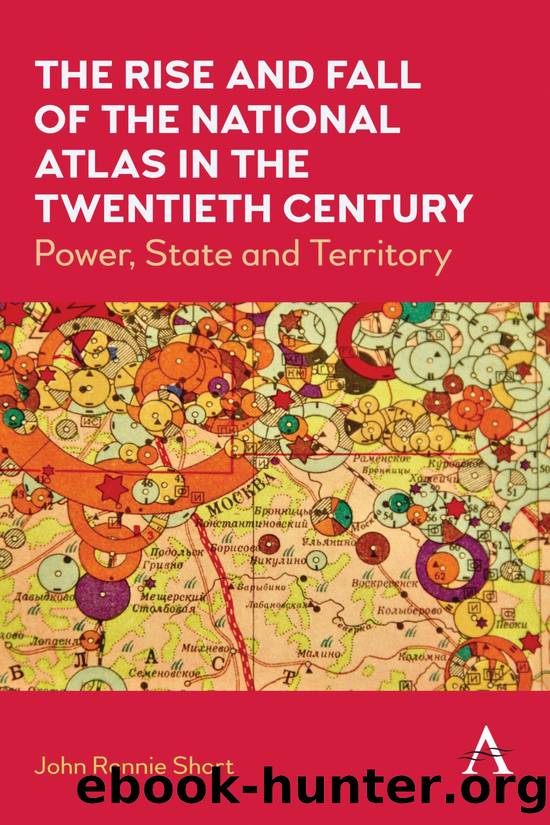The Rise and Fall of the National Atlas in the Twentieth Century by John Rennie Short;

Author:John Rennie Short;
Language: eng
Format: epub
ISBN: 9781839983054
Publisher: Lightning Source Inc. (Tier 2)
Published: 2022-06-03T00:00:00+00:00
Science, State and the National Atlas
Knowledge is always collected for a purpose, for reasons related to power. The national atlas of the twentieth century is intimately connected to the state, governance and statecraft. We have already touched on some of the reasons of statecraft: the need for legitimacy, the need to create a resource inventory, providing an image of the nation-states to both citizens and a wider world, to be seen as modern and to be seen as a member of the international community of modern, independent states. Here, I want to focus on the national atlas as a coproduction of science and the state.6
What do we mean by âcoproductionâ? The national atlas is a product of a globalizing discourse of science. Scientific discourses as varied as climatology, demography, economics and ecology are employed and utilized in the national atlas. Similar themes appeared as the standards of the global epistemic community, including forms of data creation, data assembly and data display were widely adopted across the range of national atlases. The national atlas is a form of normal science where agreed-upon standards are followed and adopted. The atlas is both a product and a producer of science.
The range of topics covered and the way they are represented have a remarkable similarity in the many different national atlases as they all share a similar scientific viewpoint. Figures 6.2 and 6.3 are rainfall maps from, respectively, the 1928 Atlas de lâindochine and the 1979 Atlas de Venezuela. Although created in different political contexts, one colonial the other an independent nation-state, and at different times, over a fifty-year time span, they are very similar. Both employ a similar form of rainfall gradation and even color palette. They use standard hydrographic categories to create similar maps of the same phenomenon albeit of different places at different times. Both maps draw upon the same repertoire of scientific categorization and data display techniques.
Figure 6.2 Rainfall map, Atlas de LâIndochine, 1928.
Source: Photo by John Rennie Short.
Figure 6.3 Rainfall map, Atlas de Venezuela, 1979.
Source: Photo by John Rennie Short.
The science in and of the national atlas is also intimately connected with the state and the state formation of scientific enterprises. The state is a central element in political thought and practice. General ideas range from the Marxist notion of the state as an embodiment of the interest of the capitalist class, to one that sees the state as having a measure of relative autonomy from the immediate interests of specific classes. Other viewpoints point to the progressive possibilities at times of crises for the state in capitalist societies. More specifically, however, scholars have drawn attention to the role of science in state formation. States are constituted by knowledge practices just as knowledge is constituted by and through the state. The national atlas is a product of this relationship as the knowledge generation, production and dissemination of state practices are in turn guided and shaped by global and national epistemic communities.
Science is produced and reproduced by the state in and through the national atlas.
Download
This site does not store any files on its server. We only index and link to content provided by other sites. Please contact the content providers to delete copyright contents if any and email us, we'll remove relevant links or contents immediately.
Spell It Out by David Crystal(35854)
Life for Me Ain't Been No Crystal Stair by Susan Sheehan(35539)
Cecilia; Or, Memoirs of an Heiress — Volume 1 by Fanny Burney(32075)
Cecilia; Or, Memoirs of an Heiress — Volume 3 by Fanny Burney(31469)
Cecilia; Or, Memoirs of an Heiress — Volume 2 by Fanny Burney(31419)
The Great Music City by Andrea Baker(30796)
Professional Troublemaker by Luvvie Ajayi Jones(29425)
We're Going to Need More Wine by Gabrielle Union(18641)
Twilight of the Idols With the Antichrist and Ecce Homo by Friedrich Nietzsche(18307)
The Secret History by Donna Tartt(18211)
All the Missing Girls by Megan Miranda(14785)
Cat's cradle by Kurt Vonnegut(14776)
Pimp by Iceberg Slim(13797)
Bombshells: Glamour Girls of a Lifetime by Sullivan Steve(13698)
Fifty Shades Freed by E L James(12924)
Talking to Strangers by Malcolm Gladwell(12888)
Norse Mythology by Gaiman Neil(12860)
The Social Justice Warrior Handbook by Lisa De Pasquale(11957)
Underground: A Human History of the Worlds Beneath Our Feet by Will Hunt(11846)
